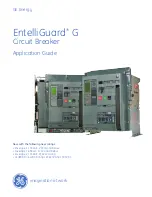
1
2
3
DCB r e a k
– InstructIons for InstallatIon, servIce and maIntenance
28
12.4. Inspection procedure
12.4.1. Inspection of quenching chute
•
Remove the cover of the quenching chute from
above.
•
Eliminate dust and residues.
•
Make sure there is no abnormal wear inside the
quenching chute, such as extensive melting on the
metal plates.
•
Check for the presence of short-circuits between
each pair of plates using an Ohmmeter.
12.4.2. Inspection of contact wear
•
Perform a visual inspection to assess the thick-
ness of the contact pads and whether they have
been worn evenly (note: when new, the contact
pads are 2.5 mm thick, measured from the copper
support to which they are welded).
•
Clean the surfaces of the contacts using a fine-
grain file or abrasive cloth, as necessary.
•
If wear has noticeably reduced the thickness of the
pads, proceed with the inspection described in the
next point.
•
Connect the ohmmeter to terminals (1) (2) and set
it to the sound mode.
•
Close the circuit breaker.
•
If there is no continuity, fully tighten an M8 x 60
screw (3) behind the actuator then unscrew it by
one turn. If the ohmmeter fails to indicate electri-
cal continuity, it means that the contacts have
reached their wear limit and must be replaced.
12.4.3. Flexible movable part
Check whether the first copper blades of the
movable part are undamaged. Replace the
connection if the first layer is damaged.
Replacement is not necessarily required in the
presence of cracks. The operator must assess
whether the crack is able to affect dielectric
clearance, considering the forecast increase in wear
until the next inspection.
12.4.4. Screws
Make sure that the screws are tight. Re-tighten
them to the required tighing torque if necessary.
—
12. Maintenance
Содержание DCBreak 1815
Страница 31: ...DISTRIBUTION SOLUTIONS 31 Notes ...































